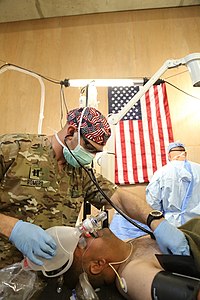
Photo from wikipedia
&NA; The number of children with caries requiring general anesthesia to achieve comprehensive dental care and the demand for dentist anesthesiologists to provide ambulatory anesthesia for these patients is increasing.… Click to show full abstract
&NA; The number of children with caries requiring general anesthesia to achieve comprehensive dental care and the demand for dentist anesthesiologists to provide ambulatory anesthesia for these patients is increasing. No current published studies examine the safety and outcomes of ambulatory anesthesia performed by dentist anesthesiologists for dental procedures in pediatric patients, and there is no national requirement for reporting outcomes of these procedures. In 2010, the Society for Ambulatory Anesthesia Clinical Outcomes Registry was developed. This Web‐based database allows providers of ambulatory anesthesia to track patient demographics and various outcomes of procedures. Our study is a secondary analysis of data collected in the registry over a 4‐year period, 2010–2014. Of the 7041 cases reviewed, no cases resulted in serious complications, including death, anaphylaxis, aspiration, cardiovascular adverse events, or neurologic adverse events. Of the 7041 cases reviewed, 196 (3.0%) resulted in a predischarge or postdischarge adverse event. The predischarge adverse event occurring with the highest frequency was laryngospasm, occurring in 35 cases (0.50%). The postdischarge adverse event occurring with the highest frequency was nausea, reported by 99 patients (5.0%). This study provides strong clinical outcomes data to support the safety of office‐based anesthesia as performed by dentist anesthesiologists in the treatment of pediatric dental patients.
Journal Title: Anesthesia Progress
Year Published: 2018
Link to full text (if available)
Share on Social Media: Sign Up to like & get
recommendations!